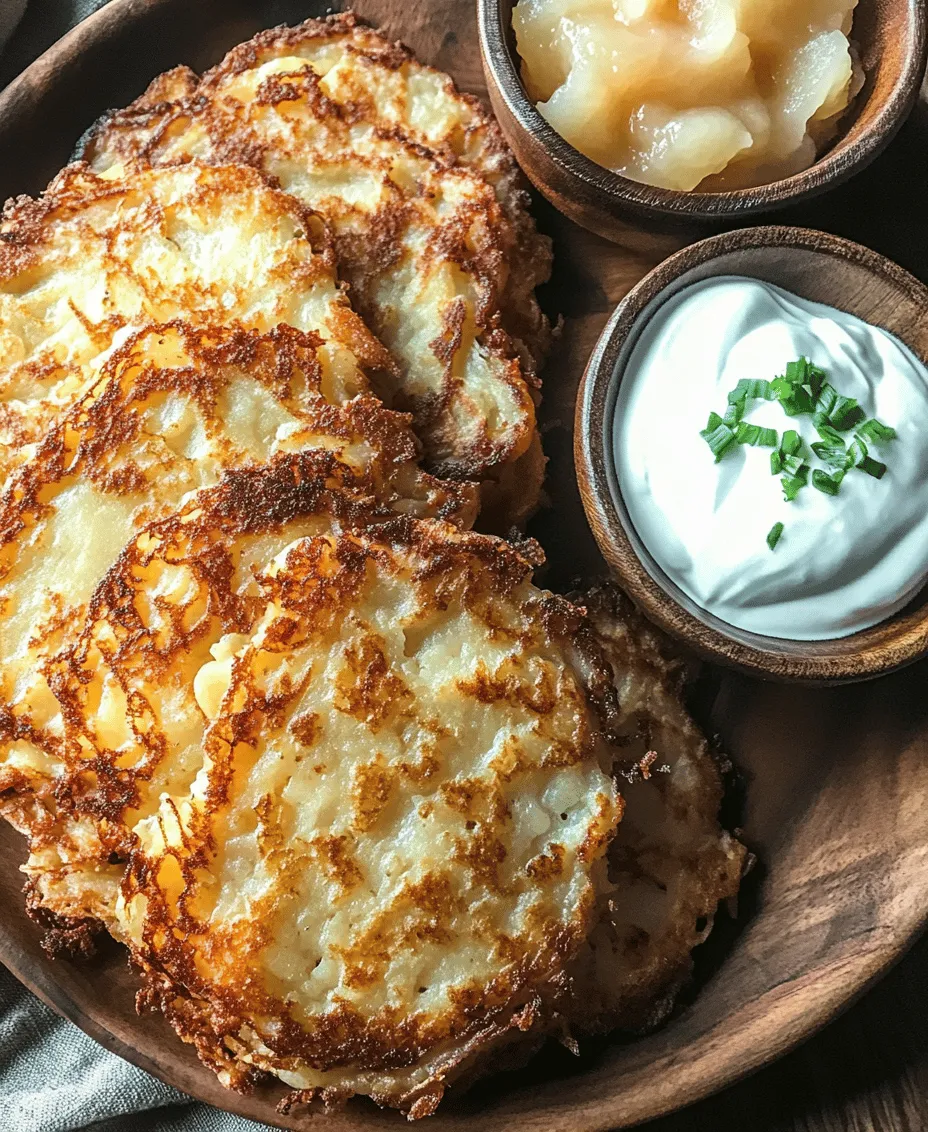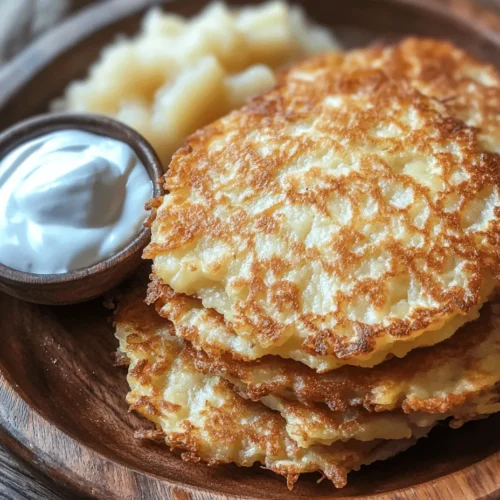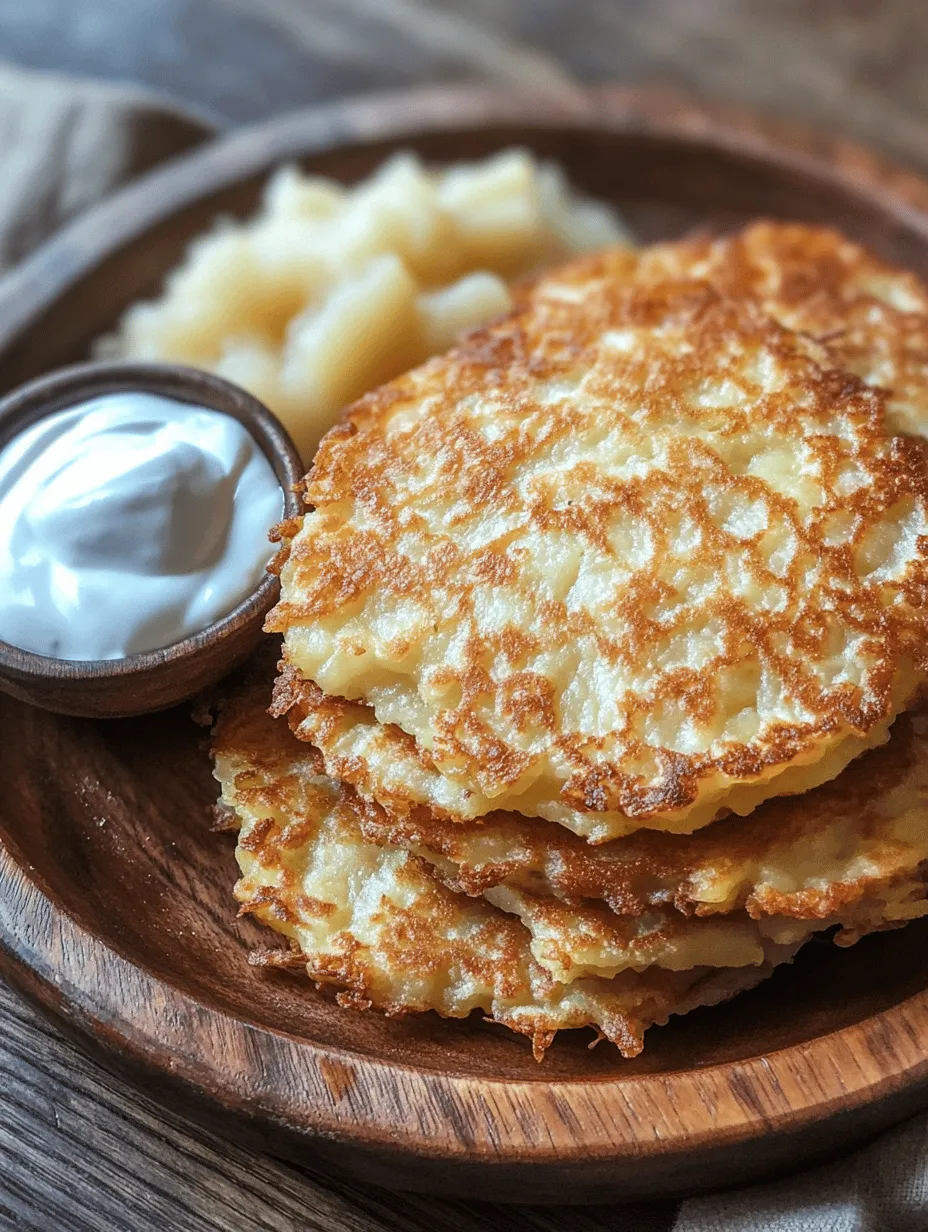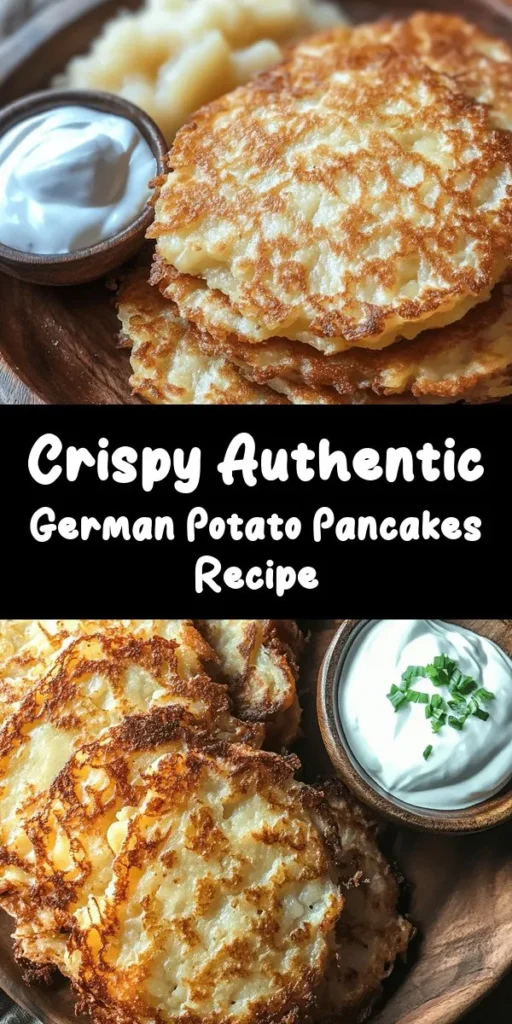Introduction
Reibekuchen, the authentic German potato pancakes, hold a cherished place in the culinary landscape of Germany. These crispy, golden delights are not just a dish; they represent a piece of the country’s cultural heritage. Every bite of Reibekuchen brings forth a symphony of flavors and textures that evoke memories of family gatherings, festive markets, and home-cooked comfort. Whether served as a delightful appetizer, a side dish, or a stand-alone snack, these potato pancakes are beloved by many for their simplicity and satisfying nature.
The beauty of Reibekuchen lies in their straightforward ingredient list, making them accessible to both seasoned cooks and kitchen novices alike. With just a handful of ingredients—potatoes, onions, eggs, flour, and seasonings—these pancakes embody the joy of homemade cooking. The process of grating, mixing, and frying is not only therapeutic but also a way to connect with tradition. As you prepare these potato pancakes, you will experience the delightful transformation of humble potatoes into a crispy, mouthwatering treat.
The History of Reibekuchen
The origins of Reibekuchen can be traced back several centuries, deeply embedded in the heart of German culinary tradition. While the precise inception of potato pancakes is difficult to pinpoint, it is believed that the use of potatoes in cooking surged in Germany during the 18th century, following their introduction to Europe from the Americas. As a result, Reibekuchen became a staple in German households, a testament to the resourcefulness of home cooks who sought to create delicious meals from readily available ingredients.
Different regions of Germany have their own unique takes on potato pancakes, showcasing the versatility of this beloved dish. In the Rhineland, Reibekuchen is often enjoyed at festive markets, served hot and crispy with apple sauce or sour cream. Meanwhile, in the north, variations may include the addition of herbs or spices, lending a distinct flavor profile. These regional adaptations highlight the rich tapestry of German cuisine, where local ingredients and traditions influence the way food is prepared and served.
Reibekuchen is more than just a culinary delight; it is a symbol of community and celebration. These potato pancakes often make an appearance during festivals and family gatherings, where they are enjoyed by young and old alike. The act of preparing and sharing Reibekuchen brings families together, fostering connections that transcend generations. Whether enjoyed at a Christmas market or a summer fair, the warm, inviting aroma of frying potato pancakes is sure to evoke nostalgia and a sense of belonging.
Understanding the Key Ingredients
To create authentic Reibekuchen, it’s essential to understand the role of each ingredient in the recipe. The success of these potato pancakes lies not only in their preparation but also in the quality and type of ingredients used.
Potatoes
Potatoes are the star ingredient in Reibekuchen, and the type of potato you choose can significantly impact the final texture and flavor of the pancakes. Starchy potatoes, such as Russets or Idaho potatoes, are ideal for this dish. They have a high starch content, which helps achieve that perfect crispy exterior while maintaining a soft and tender interior. Waxy potatoes, on the other hand, tend to hold their shape better when cooked and may not yield the desired crispiness. Therefore, for the best results, opting for starchy potatoes is highly recommended.
Onion
Onion is another crucial element in the flavor profile of Reibekuchen. It adds a subtle sweetness and depth of flavor that enhances the overall taste of the pancakes. When grated and mixed into the potato mixture, onions provide moisture, which helps bind the ingredients together while also infusing the pancakes with a savory richness. The balance of potato and onion is key to achieving that perfect harmony of flavors.
Egg
Eggs play a vital role in binding the ingredients together, ensuring that the potato mixture holds its shape during frying. They also contribute to the overall texture of the pancakes, helping to create a slightly fluffy interior while maintaining a crisp exterior. It’s essential to use fresh eggs for the best results, as they provide the necessary structure and moisture to the mixture.
Flour
Flour is used to add structure and a bit of crispiness to the Reibekuchen. It absorbs excess moisture from the grated potatoes and onions, preventing the pancakes from becoming too soggy. The right amount of flour will help achieve that delicate balance between a crispy outer layer and a soft, tender center. For those with dietary restrictions, gluten-free alternatives such as almond flour or rice flour can be used to create a gluten-free version of these delicious potato pancakes.
Seasonings
Simple seasonings like salt and pepper are essential for enhancing the flavor of the Reibekuchen. Salt not only brings out the natural flavors of the ingredients but also helps to draw out moisture from the potatoes, which is crucial for achieving the right texture. A touch of baking powder can also be added to provide a little lift, resulting in lighter pancakes. For those looking to elevate the flavor further, feel free to experiment with additional seasonings like garlic powder, nutmeg, or fresh herbs.
Step-by-Step Guide to Making Authentic German Potato Pancakes
Now that we have a solid understanding of the ingredients, let’s dive into the step-by-step process of making authentic German potato pancakes. Making Reibekuchen is straightforward, and with a little practice, you’ll be able to whip up a batch in no time.
Step 1: Preparing the Potatoes
The first step in making Reibekuchen is to prepare your potatoes. Start by selecting your starchy potatoes and give them a good wash to remove any dirt or impurities. Once clean, peel the potatoes using a vegetable peeler, ensuring to remove all skin. This step is crucial because the skin can affect the texture of the pancakes.
Next, it’s time to grate the potatoes. A box grater or food processor fitted with a grating attachment works best for this task. Grate the potatoes into a large bowl, taking care to avoid any large chunks. The finer you grate the potatoes, the smoother your pancake mixture will be. After grating, it’s essential to drain any excess moisture from the grated potatoes. You can do this by placing the grated potatoes in a clean kitchen towel and squeezing out the liquid. This step is vital for achieving that crispy texture, as excess moisture can lead to soggy pancakes.
Step 2: Grating the Onion
In this step, you will also need to grate the onion. Just like with the potatoes, use a box grater or food processor to finely grate the onion. Once grated, add the onion to the bowl with the grated potatoes. The onion will release some moisture, which helps bind the mixture, but you still want to ensure that you don’t have too much liquid.
Step 3: Mixing the Ingredients
Now that your potatoes and onions are ready, it’s time to mix in the remaining ingredients. Crack the eggs into the bowl with the grated potatoes and onions. Sprinkle in the flour, along with salt, pepper, and baking powder. Using a fork or your hands, gently mix everything together until just combined. Be careful not to overmix, as this can lead to tough pancakes. The goal is to have a cohesive mixture where the potatoes and onions are well distributed, and the eggs and flour have thoroughly incorporated.
Step 4: Frying the Pancakes
In a large skillet or frying pan, heat a generous amount of oil over medium-high heat. The oil should be hot enough that when you drop a small amount of the potato mixture into the pan, it sizzles immediately. Using a spoon or a small ice cream scoop, portion out the mixture and carefully place it into the hot oil, flattening it slightly with the back of the spoon to form a pancake shape. Fry for about 3-4 minutes on each side, or until golden brown and crispy. It’s important not to overcrowd the pan, as this can lower the oil temperature and lead to soggy pancakes.
Once cooked, transfer the fried pancakes onto a plate lined with paper towels to drain any excess oil. This step will ensure your Reibekuchen is crispy and not greasy.
As you continue frying the remaining mixture, you may need to adjust the heat to ensure even cooking without burning the pancakes. Enjoy the delightful aroma that wafts through your kitchen as you prepare this classic dish, paving the way for the final steps of your authentic German potato pancake experience.

Importance of Soaking and Draining the Potatoes for Crispiness
When it comes to achieving the perfect texture for your authentic German potato pancakes, known as Reibekuchen, the process of soaking and draining the potatoes is crucial. Potatoes contain a significant amount of moisture, and if not properly managed, this moisture can lead to soggy pancakes instead of the desired crispiness.
To begin, peel your potatoes and then grate them using a box grater or a food processor. After grating, transfer the potatoes to a bowl of cold water and let them soak for about 30 minutes. This soaking process helps to remove excess starch, which can make the pancakes gummy. Following the soak, drain the potatoes thoroughly and press them gently with a clean kitchen towel or cheesecloth to remove as much moisture as possible. The drier the potatoes, the crispier your pancakes will be.
Mixing the Ingredients: Best Practices for Incorporation
Once your potatoes are soaked and drained, it’s time to mix them with the other ingredients. The traditional recipe for Reibekuchen is simple but effective, highlighting the potatoes’ natural flavor.
In a mixing bowl, combine the grated potatoes with finely chopped onions, eggs, flour, salt, and pepper. When incorporating these ingredients, it’s essential to mix them gently and evenly, ensuring that the flour is well-distributed without overworking the mixture. Overmixing can lead to a dense texture, which we want to avoid.
A tip for better incorporation is to add the flour gradually — sprinkle it over the potato mixture while folding it in. This approach allows for even mixing, preventing clumps and ensuring that every pancake has the right consistency.
Heating the Oil: Tips for Achieving the Right Frying Temperature
The frying process is where Reibekuchen can truly shine, and getting the oil temperature correct is key to achieving that golden brown, crispy exterior. Use a heavy-bottomed skillet or a cast-iron pan for even heat distribution and stability.
Before adding your potato mixture to the pan, heat about half an inch of vegetable oil (such as canola or sunflower oil) over medium-high heat. To test if the oil is ready, drop a small amount of the potato mixture into the oil; if it sizzles immediately and rises to the surface, the oil is at the right temperature. It’s essential not to overcrowd the pan, as this can lower the oil’s temperature, leading to soggy pancakes. Fry in batches if necessary.
Frying Techniques: How to Achieve the Perfect Golden Brown Color and Texture
Once the oil is hot, carefully spoon the potato mixture into the pan, flattening each mound slightly with the back of the spoon to form pancakes. Each pancake should be about ¼ inch thick to ensure even cooking.
Fry the pancakes for about 4-5 minutes on each side, or until they develop a beautiful golden brown color. If you find that they are browning too quickly, reduce the heat slightly to ensure that they cook through without burning. It’s important to resist the urge to flip them too soon; allow them to develop a crust that will enhance both texture and flavor.
To maintain the crispiness of the pancakes, avoid pressing down on them with the spatula, as this can release moisture and make them soggy. Instead, gently lift and turn them with care.
Draining Excess Oil: Best Practices to Maintain Crispiness
After frying, it’s essential to drain the excess oil to retain the crispiness of your Reibekuchen. Use a slotted spatula to transfer the pancakes to a plate lined with paper towels, which will absorb any leftover oil. For optimal results, keep the cooked pancakes warm in an oven set to low heat (around 200°F or 93°C) while you finish frying the remaining batches.
If you want an extra layer of crispiness, consider placing the pancakes on a wire rack instead of a paper towel. This allows air to circulate around the pancakes, preventing them from steaming and losing their crunch.
Serving Suggestions and Pairings
Traditional Accompaniments: Applesauce and Sour Cream Explained
Reibekuchen are traditionally served with applesauce and sour cream, which offer a delightful contrast to the savory flavor of the pancakes. The sweetness of the applesauce pairs beautifully with the crispy, salty pancakes, while sour cream adds a creamy tanginess that enhances the overall dish.
To serve, place a generous scoop of applesauce on the side of your plate, along with a dollop of sour cream. This classic combination not only respects tradition but also elevates the flavor profile of the pancakes.
Suggestions for Modern Twists: Incorporating Different Dips or Toppings
While applesauce and sour cream are timeless accompaniments, don’t hesitate to get creative with your toppings. For a modern twist, consider serving your Reibekuchen with herb yogurt, which can be made by mixing plain yogurt with fresh herbs like dill or chives. This adds a refreshing note that complements the rich flavor of the pancakes.
Another innovative option is to top the pancakes with smoked salmon, capers, and a squeeze of lemon juice. This combination brings a luxurious touch to your meal, making it suitable for brunch or special occasions.
Ideas for Complete Meals: Pairing with Salads or Proteins
To create a balanced meal, consider pairing your Reibekuchen with a fresh salad or a protein source. A simple arugula salad dressed with lemon vinaigrette can provide a peppery contrast, while grilled chicken or fish can add heartiness to your plate.
For a traditional German meal, serve the pancakes alongside a hearty portion of sauerkraut or a side of rotkohl (red cabbage), adding depth and flavor to your dining experience.
Nutritional Value of German Potato Pancakes
To enjoy your Reibekuchen guilt-free, it’s helpful to understand their nutritional content. Each serving of authentic German potato pancakes typically contains around 200-250 calories, depending on the size and amount of oil used in frying. The pancakes are primarily made up of carbohydrates from the potatoes, with a moderate amount of fat due to the frying process.
Breakdown of Nutritional Content Per Serving
– Calories: 200-250
– Fat: 10-15g
– Carbohydrates: 30-35g
– Protein: 3-5g
Discussion of Potential Health Benefits of the Main Ingredients
Potatoes are a good source of vitamins C and B6, potassium, and dietary fiber. They can be beneficial for digestion and may help in maintaining healthy blood pressure levels. Onions, another key ingredient, are rich in antioxidants and may provide anti-inflammatory benefits.
While Reibekuchen are a treat best enjoyed in moderation due to their frying method, they can certainly fit within a balanced diet when paired with nutritious sides and enjoyed as part of a varied meal plan.
Cultural Significance of Reibekuchen Today
Reibekuchen holds a special place in contemporary German culture, often enjoyed at Christmas markets and festivals throughout Germany. They symbolize comfort and home-cooked meals, evoking memories of family gatherings and holiday traditions.
The Role of Potato Pancakes in Modern Culinary Practices and Trends
In recent years, there has been a resurgence of interest in traditional comfort foods, with Reibekuchen making a comeback as a beloved dish that transcends generations. Modern culinary practices incorporate these pancakes into diverse menus, showcasing their versatility in both casual dining and gourmet settings.
Personal Anecdotes or Testimonials
Many people cherish Reibekuchen as a childhood favorite, recalling the aroma of freshly fried pancakes wafting through their homes. For instance, one food enthusiast shared how her grandmother’s Reibekuchen recipe was a staple during family gatherings, bringing everyone together around the table. These personal stories reflect the dish’s emotional connection and its ability to create lasting memories.
Conclusion
Making authentic German potato pancakes at home is not just about preparing a delicious dish; it’s about celebrating a rich cultural heritage that brings people together. The joy of creating Reibekuchen from scratch, from soaking the potatoes to frying them to a perfect golden brown, is a rewarding experience that can be shared with family and friends.
As you savor the crispy texture and the delightful combination of flavors with applesauce and sour cream, you’ll appreciate the tradition and comfort that these pancakes represent. We invite you to try this recipe, explore the various serving suggestions, and immerse yourself in the culinary heritage of Germany. Whether served at a festive gathering or a cozy family dinner, Reibekuchen is sure to bring joy and satisfaction to your table.



